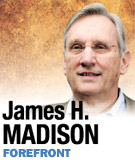Subscriber Benefit
As a subscriber you can listen to articles at work, in the car, or while you work out. Subscribe Now
 Is Indiana in the midst of a revolution? Thinking about change over the last half century, Gov. Mitch Daniels said recently, “We’re in a completely different world, of course. A completely different world.”
Is Indiana in the midst of a revolution? Thinking about change over the last half century, Gov. Mitch Daniels said recently, “We’re in a completely different world, of course. A completely different world.”
I wrote a history of Indiana long ago (1986). “The Indiana Way” argued that there had never been a revolution in the state: “Evolution, not revolution, was the route taken in Indiana.”
I’m now rewriting that book. Do I need to change the central argument? Are we in the midst of a revolution? Is there a new Indiana way?
There is certainly evidence of change: small things such as roundabouts, larger changes such as Japanese auto factories in former cornfields.
The old Indianapolis is surely changed. It’s no longer just another town, once bigger but not much different from others across the state. We may even be moving toward two Indianas, one more educated and wealthy in the central region, the other, the outlying places, poorer, less educated, less prepared for the 21st century.
Are these changes really revolutionary? Historians specialize in the long view, which tends to damper such claims.
The men who wrote the state’s constitution in 1816 under the shade of a Corydon elm tree likely thought they were living in a completely different world. So, too, did Gov. Oliver Morton during the Civil War, Gov. Paul McNutt in the Great Depression, and Eli Lilly in bringing insulin to McCarty Street in the 1920s.
More important than how much evolution or revolution, however, is our response. There have been Hoosiers who “opposed the new and innovative and were able to resist,” I wrote in 1986, so that the “state could be backward and out of step, its people close-minded and provincial.”
Does that darker possibility linger? Can we still stick our heads in the sand and pretend that all will continue as it has been? Are there Hoosiers still waiting for 1950s-type manufacturing jobs or another Milan miracle?
We don’t need to accept all the changes that experts tell us are good. There remains something virtuous about the Indiana tendency toward moderation, toward skepticism, toward remembering that continuity may be mixed with change, even revolutionary change. McCarthyism was slower to take hold here in the 1950s partly because Hoosiers were wary of new movements.
To think about change today demands larger frameworks. We spend so much time chewing on the small stuff that we don’t get to the main course.
Generations of Hoosiers before our time made smart and dumb choices. They created the most abundant cornfields in the world, the most productive manufacturing assembly lines, and the best basketball teams. They also once decided that only white men should vote, that the Ku Klux Klan was a great Christian reform movement, and that canals were a better investment than railroads.
Historians like me have the luxury of not voting yes or no. We usually press a third button marked “ambiguity.” Our past is full of ambiguity, shades of gray, multiple perspectives. The really important history questions are not true-false.
The present is the same. We’d be better served if we could see the ambiguities rather than the binaries, if we could really think, read and talk (to use the motto of Indiana Humanities), if we thought as big as Cody Zeller running the floor. We might decide then to sweat more about education, infrastructure, local government, the environment and dozens of other matters that are not small stuff.
As we approach our bicentennial of statehood in 2016, there are opportunities to take this long view and really think about the big stuff in contexts of where we have been. We just might celebrate our 200th birthday in a way that will have more long-term consequences for Hoosiers than the fun of Super Bowl XLVI.
We might figure out how we can have evolutionary and revolutionary change, our present world and a different world, our own Indiana way.•
__________
Madison is a professor of history at Indiana University and the author of “The Indiana Way: A State History.” Send comments to ibjedit@ibj.com
Please enable JavaScript to view this content.
